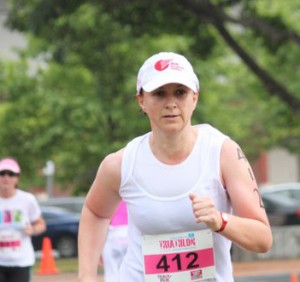Set a training goal and stick to it

If you going to do any physical training then you need to have a goal because without one you’ll come up with lots of excuses and never really get anywhere.
A great way to set a goal is to sign up for an event. It could be anything from a short fun cycling event like Sydney’s Spring Cycle (55 km) or Melbourne’s short version of Around the Bay (50 km option), right up to a serious level race. The key is to select an event that will challenge you but won’t break you.
I actually took up cycling four and a half years ago to participate in a charity bike ride – The Juvenile Diabetes Research Foundation (JDRF) Ride for a Cure that is held in the Barossa Valley, SA in January every year. I’ve recently completed my fifth JDRF ride. The first three years I completed the 80 km course and not surprising it got easier every year. The fourth and fifth times I upped it to 160 km and once again the second year was easier than the first, particuarly from a mental perspective.
In preparation for any event like that you literally have to plan how far you will commit to ride each week and stick with it. That doesn’t mean you have to be completely rigid because you might have other commitments like work, family and a social life but you do have to be dedicated. That could mean you have to make a few sacrifices like having less to drink at a party and driving home because you have to get up early to get on that bike.
I use an Excel spreadsheet to record my forward plans for training. If you don’t plan, then it will creep up on you and you’ll run out of time to get those long rides in. Incidentally most of what I’ve read about training for long rides says that you don’t have to do the full distance you just have to consistently do some longer rides leading up to the event. For example, in the four weeks leading up to my 160 km ride I’ll did at least a 120 km and 2 x 140 km rides. The key to cycling is to get the ‘Ks into your legs’ as they say.
I also have an indoor bike trainer set up in my garage so that if it rains I don’t stay in bed. I get up and use the indoor trainer with a training DVD (in my case Spinervals) which can be a real challenge.
The same theory applies to other events too. I completed a mini-triathlon in October and leading up to it I planned my training, which of course needed to include swimming, running and riding. The event was the Pink Triathlon which is a 300 metre swim, 9 km bike ride and 3 km run.
Swimming is my weakest leg so I had to train at least twice a week for about six weeks leading up to it to make sure I wouldn’t disgrace myself on the day. I knew I didn’t need to specifically train for the bike leg because I ride further than that every time I take my bike out and I also jog pretty regularly so I just needed to increase that a little. As a consequence I did what I consider a pretty good time in the Pink Triathlon.
It’s also great if you can find a training partner. I had one for the pink triathlon and it was a great incentive to get out the door for training if I knew my friend was waiting. I’ve also had cycle training partners in the past who haven’t actually been completing the same event as me but have offered to come along to keep me company on those long training rides. They benefit too because they get fit at the same time.
And of course if you want to take it up a level you can hire a coach/trainer who will help you prepare for an event. I haven’t taken that step yet but I’ve thought about it. I do have a personal training session once a week and I always mention my latest event and what I’m trying to achieve in my training sessions. In these sessions I usually do exercises that complement my event discipline rather than duplicate it.
So my recommendation would be to find an event, make sure it’s long enough away (but not too far) and start training. You’ll be surprised at what you can achieve and how much you can enjoy an event if you’re fully prepared.
